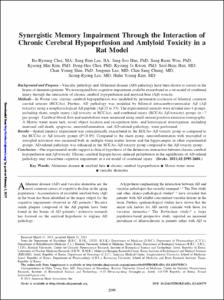Synergistic Memory Impairment Through the Interaction of Chronic Cerebral Hypoperfusion and Amlyloid Toxicity in a Rat Model
- Keimyung Author(s)
- Lee, Seong Ryong
- Journal Title
- Stroke
- Issued Date
- 2011
- Volume
- 42
- Issue
- 9
- Keyword
- Alzheimer disease; amyloid beta; chronic cerebral hypoperfusion; Morris water maze; vascular dementia
- Abstract
- Background and Purpose: Vascular pathology and Alzheimer disease (AD) pathology have been shown to coexist in the brains of dementia patients. We investigated how cognitive impairment could be exacerbated in a rat model of combined injury through the interaction of chronic cerebral hypoperfusion and amyloid beta (Aβ) toxicity.
Methods: In Wistar rats, chronic cerebral hypoperfusion was modeled by permanent occlusion of bilateral common carotid arteries (BCCAo). Further, AD pathology was modeled by bilateral intracerebroventricular Aβ (Aβ toxicity) using a nonphysiological Aβ peptide (Aβ 25 to 35). The experimental animals were divided into 4 groups, including sham, single injury (Aβ toxicity or BCCAo), and combined injury (BCCAo-Aβ toxicity) groups (n=7 per group) . Cerebral blood flow and metabolism were measured using small animal positron emission tomography. A Morris water maze task, novel object location and recognition tests, and histological investigation, including neuronal cell death, apoptosis, neuroinflammation, and AD-related pathology, were performed.
Results: Spatial memory impairment was synergistically exacerbated in the BCCAo–Aβ toxicity group as compared to the BCCAo or Aβ toxicity groups (P<0.05). Compared to the sham group, neuroinflammation with microglial or astroglial activation was increased both in multiple white matter lesions and the hippocampus in other experimental groups. AD-related pathology was enhanced in the BCCAo–Aβ toxicity group compared to the Aβ toxicity group.
Conclusion: Our experimental results support a clinical hypothesis of the deleterious interaction between chronic cerebral hypoperfusion and Aβ toxicity. Chronic cerebral hypoperfusion-induced perturbation in the equilibrium of AD-related pathology may exacerbate cognitive impairment in a rat model of combined injury.
- Keimyung Author(s)(Kor)
- 이성용
- Publisher
- School of Medicine
- Citation
- Bo-Ryoung Choi et al. (2011). Synergistic Memory Impairment Through the Interaction of Chronic Cerebral Hypoperfusion and Amlyloid Toxicity in a Rat Model. Stroke, 42(9), 2595–2604. doi: 10.1161/STROKEAHA.111.620179
- Type
- Article
- ISSN
- 0039-2499
- Appears in Collections:
- 3. Research Institutues (연구소) > Brain Research Institute (뇌연구소)
1. School of Medicine (의과대학) > Dept. of Pharmacology (약리학)
- 파일 목록
-
-
Download
 oak-aaa-4374.pdf
기타 데이터 / 1.97 MB / Adobe PDF
oak-aaa-4374.pdf
기타 데이터 / 1.97 MB / Adobe PDF
-
Items in Repository are protected by copyright, with all rights reserved, unless otherwise indicated.